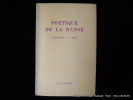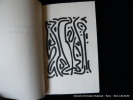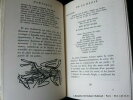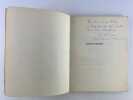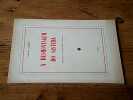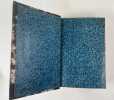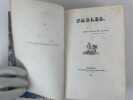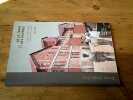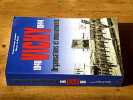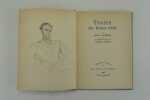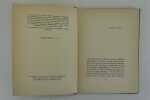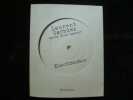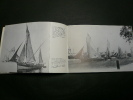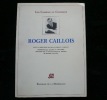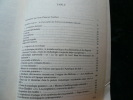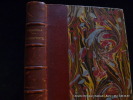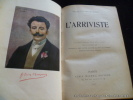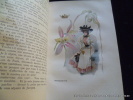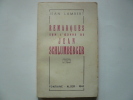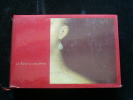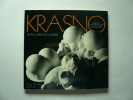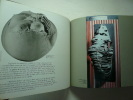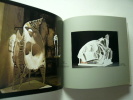2900 books for « lambert e »Edit
-
Type
Book (2851)
Engraving (1)
Magazine (18)
Music sheets (48)
New book (1)
Photographs (3)
Posters (1)
-
Latest
Last 3 days (7)
Last month (121)
Last week (2)
-
Language
Dutch (2)
English (3)
French (2917)
Italian (1)
-
Century
16th (1)
17th (4)
18th (83)
19th (187)
20th (1323)
21st (277)
-
Countries
Belgium (215)
Brazil (1)
Canada (20)
China (1)
Côte d'Ivoire (4)
Denmark (28)
France (2430)
Germany (11)
Greece (1)
Italy (32)
Netherlands (1)
Switzerland (178)
United Kingdom (1)
-
Syndicate
ALAC (20)
CLAM (6)
CLAQ (1)
CNE (2)
ILAB (1310)
NVVA (19)
SLACES (19)
SLAM (1225)
SNCAO (30)
Topics
- Adam (34)
- Archaeology (18)
- Architecture (27)
- Autographs (39)
- Belgium (20)
- Bibliography (10)
- Biography (17)
- Botany (29)
- Brittany (21)
- Brussels (14)
- Cassandra (10)
- Catholicism (10)
- Children’s books (54)
- China (14)
- Christianity (16)
- Collaboration (14)
- Comic strip (17)
- Cooking (29)
- Culinary art (13)
- Dedication (28)
- Early printed books (16)
- Economics (20)
- Education (23)
- Education - morals (15)
- Esotericism (10)
- Ethnology (10)
- Fine arts (38)
- First edition (29)
- Genealogy (10)
- Geography (13)
- Geology (9)
- Hackney (10)
- Helvética (10)
- History (117)
- Lambert alain (13)
- Lambert andré (30)
- Lambert bernard (18)
- Lambert christophe (40)
- Lambert david (16)
- Lambert denis-clair (10)
- Lambert dominique (9)
- Lambert elie (28)
- Lambert fernand (17)
- Lambert gilles (26)
- Lambert gustave (9)
- Lambert jacques (14)
- Lambert jean (42)
- Lambert jean-clarence (33)
- Lambert lucien (10)
- Lambert marc (26)
- Lambert michel (10)
- Lambert nicole (9)
- Lambert paul (16)
- Lambert-faivre yvonne (9)
- Languedoc (11)
- Law (25)
- Literature (196)
- Magazine (30)
- Manuscripts (14)
- Medicine (24)
- Mountaineering climbing (15)
- Music (12)
- Newspapers press (55)
- Painters (13)
- Painting (23)
- Paris (30)
- Philosophy (23)
- Photography (13)
- Poetry (58)
- Policy (15)
- Provence (28)
- Psychology (13)
- Reading vocabulary (17)
- Regionalism (16)
- Religions (34)
- Review (37)
- Reviews (36)
- Saint lambert (96)
- Sciences (16)
- Sciences & technique (10)
- Scores (59)
- Sociology (10)
- Songs (48)
- Sports (11)
- Swerts lambert (15)
- Switzerland (16)
- Tales (12)
- Tea (11)
- Teaching (12)
- Theatre (31)
- Theology (16)
- Travel (18)
- Various (19)
- War (26)
- Women (the) (24)
- Youth (16)
Avec des poèmes de Euripide, Kabir, Tagore, W. der Vogelweide, Gongora, Schiller, Lenau, Nietzsche, Mallarmé, Claudel, Valéry, Rilke, Garcia Lorca, Erik Lindegren, Eluard, Aragon, Césaire. Choix et commentaire de Jean-Clarence Lambert.
Reference : 71116
(1965)
Poétique de la danse d''Euripide à Lorca. Illustrations Stanley-William Lambert
Paris, Falaize, 1965, in-12, broché, 76 pages. Très bon état.
Dépaysage
Paris Falaize / Georges Fall éditeur 1959 17,5x22cm broché sous couverture illustrée Edition originale. Un des 750 ex. numérotés sur fleur d'Alfa, après 60 ex. de tête, avec une illustration de Pierre Soulages en couverture tirée dans les ateliers Mourlot. Envoi de l'auteur au collectionneur et compagnon des surréalistes Lucien Biton. Très bon état.
A desmontagem do sistema. Relaçao da subversao polaca
Fenda 1986 166 pages Coimbra. Grand In-8. 1986. broché. 166 pages.
Etat correct malgré la couverture un peu salie et quelques rousseurs aux tranches. Intérieur propre avec une signature sur la page de titre
Fables
Paris Typographie Firmin Didot Frères, 1849, in-12, demi-chagrin à coins, tête dorée, 328p. Edition hors-commerce strictement limitée à 200 ex. Contient 150 fables. Quelques rousseurs. Né à Bruxelles le 13 mars 1780, membre de la Société de Littérature de Bruxelles.
De la Terre & des Hommes : La tuilerie des Milles d'Aix-en-Provence (1882-2006)
REF.2C 2007 175 pages In-4. 2007. Broché. 175 pages. Avec de nombreuses illustrations en noir et en couleurs
Très bon état
Lambert Pierre-Philippe Le Marec Gérard
Reference : 21966
(2009)
ISBN : 9782733910511
Vichy 1940-1944 - Organisations et mouvements
Grancher 2009 520 pages in-8. 2009. Broché. 520 pages. Nombreuses illustrations en noir et en couleurs
Etat correct. Un coin de la couverture légèrement corné entrainant les pages un peu froissées en coins aux premières pages sinon bon état
Traité du beau rôle. Portrait de l'auteur par Mariano Andreu.
Paris NRF/ Gallimard/ Coll. Une oeuvre, un portrait n°3, 14 septembre 1945, in-12 (13,5x18,5cm), cartonnage éditeur, 71p. Bel exemplaire. Edition originale. Un des 1050 ex. sur châtaignier reliés d'après la maquette de Mario Prassinos. (n°142). Cf Huret. Les Cartonnages NRF, n° 297.
Les choix économiques dans l'entreprise et dans l'administration. Tome 2 : Etudes de cas
Paris Dunod (n° 44 de la Coll. "Finance et économie appliquée") 1973 273 pages in-8. 1973. broché. 273 pages. In-8 broché (239x155 mm) XII-273 pages. Les choix économiques dans l'entreprise et dans l'administration - TOME 2 : Etudes de cas. Avec tableaux et figures en noir. Couverture en très bon état. A noter des rousseurs à la tranche supérieure sinon intérieur propre. Poids : 450 gr
BRIGNONE (Andréa) LAMBERT (Jean) MARTINET (Alain) SAVALL (Henri)
Reference : 2828
(1978)
ISBN : 9782030701034
Encyclopédie de l'Economie. Le présent en question
Paris Librairie Larousse 1978 463 pages in-8. 1978. cartonné. 463 pages. In-8 cartonné (256x155 mm) 463 pages. A noter des rousseurs à la tranche supérieure sinon très bon état. Poids : 880 gr
A bibliography of algeria from the expedition of Charles V. in 1541 to 1887 & Supplement to the bibliography of algeria from the earliest times to 1895
Sans date ni nom d'éditeur concernant "A bibliography of algeria" (fin XIXème) & London John Murray (Royal geographical society 304 pages in-8. Sans date. relié. 304 pages.
Un village en Champagne
1991 291 pages in8. 1991. Broché. 291 pages. Avec des illustrations en noir
Très Bon Etat général
Admirals - The naval commanders who made britain great
Faber and faber 2008 492 pages in-12. 2008. broché. 492 pages. Avec des illustrations en noir et en couleurs
Etat correct
Amérique Latine structures sociales et institutions politiques
Presses Universitaires de France 1968 486 pages collection Thémis. in-8. 1968. broché. 486 pages. Manuels juridiques économiques et politiques
Bon état général
Sadi Ghirba, l'éveilleur de consciences ou révélations dans la montagne. Reconstitution d'un enseignement pré-initiatique. Préface du Docteur Philippe Encausse
Paris, Dervy, 1961, in-8, broché, 265 Bon état. Envoi de l'auteur.
Observations sur quelques dimensions du monde intellectual.
(Berlin, Haude et Spencer, 1770). 4to. No wrappers, as issued in ""Memoires de l'Academie Royale des Sciences et Belles Lettres"", tome XIX. Pp. 421-438. Very nice and clean.
The rare first printing of one of the few of Lambert's philosophical works that appeared within his life-time. This is one of the three philosophical papers that he published in ""Nova acta Eruditorum"", which are of varying philosophical content.The present work played a significant role in the rediscovery within philosophy of the concept of the ""sublime"", the foundational concept which was so famously treated by Kant in his third Critique (of Judgment). Neither the idea of the beautiful nor of the sublime was novel in the 18th century, as the distinction between the two had already been made in ancient philosophy. However, for several centuries, aesthetics had been dominated by the question of the beautiful, and it was only around Kant's and Lambert's time that the sublime had become a topic of interest again - this time primarily as the sublime in nature. When Lambert thus discusses the sublime in the present article, it is probable that his conception of it can have influenced Kant and his exposition in the ""Critique of Judgment"", which appeared a couple of decades later. ""Kant himself recognized Lambert as a philosopher of the highest qualities"" and he expected much from his critical attitude. He had drafted a dedication of the ""Critique of Pure Reason"" to Lambert, but Lambert's untimely death prevented its inclusion.Lambert's place in the history of philosophy, however, should not be seen only in its relation to Kant. The genesis of his philosophical ideas dates from a time when Kant's major works had yet to be conceived. It was the philosophical doctrines of Leibniz, Christian Wolff, and Locke that exerted the more important influence - insofar as one can speak of influence with a self-taught and wayward man such as Lambert... The two main aspects of Lambert's philosophy, the analytic and the constructive were both strongly shaped by mathematical notions"" hence logic played an important part in his philosophical writing. Following Leibnitz' ideas, Lambert early tried to create and ""ars characteristic conbinatoria"", or a logical or conceptual calculus. He investigated the conditions to which scientific knowledge must be subjected if it is to enjoy the same degree of exactness and evidence as mathematical knowledge..."" (D.S.B. VII:597).
Bateaux traditionnels d'entre Loire et Gironde. Catalogue d'exposition Orangerie du Muséum d'Histoire Naturelle et Ethnographie de la Rochelle
La Rochelle, Offset Astoul, 1981, 21x15cm oblong, agrafé, (22p.) Envirion 25 reproductions N/B. Très bon état.
Sous la direction de Jean-Clarence Lambert.
Reference : 76680
(1991)
ISBN : 9782729106966
Les Cahiers de Chronos. Roger Caillois. Témoignages, études et analyses, précédés de 39 textes rares ou inédits de Roger Caillois.
Paris, Editions de la Différence, 1991, in-8, broché, 453 pages. Bon état. Pliure sur la 4e de couverture. Documents hors-texte.
Félicien Champsaur. Illustrations couleurs de Bourdelle, Abel Faivre, Léandre, Maurice de Lambert, Robaudi, Paul Sain, Steinlen
Reference : 26157
(1902)
L'arriviste. Marquisette, Me Claude Barsac, Renée April
Paris, Albin Michel, 1902, in-8, Demi- chagrin, dos à 5 nerfs., 623 pages. Mors frottés. Intérieur bon.
Remarques sur l'oeuvre de Jean Schlumberger
Alger, Fontaine. Coll. Liberté de l'Esprit, 1942, in-12, broché, 155p. Couverture très légèrement piquée (cf photo) sinon bel exemplaire, très frais.
Préface de Jean-Clarence Lambert suivies de nombreux poèmes.
Reference : 76365
(1967)
Les blasons du corps féminin
Paris, André Balland 1967 Paris Relié 273 p. Nombreuses illustrations couleurs, 1967, in-12 à l'italienne, pleine toile rouge éditeur, sous rodhoïd, 273 pages. Bon état.
Krasno ou le matérialisme magique.
Paris, Paul Wurtz Editeur, 1977, 215x200mm, broché, couvertures à rabats, 60p. Très bon état. Environ 40 illustrations. Eléments de biographie établie par Georges Didi-Huberman.
Féraud, Louis. Textes de Michel Baraquand, Pierre-Yves Guillen, Gilles Lambert, Emma Staffelbach, Marie-José Treichler, André-François Villon, Hubertu
Reference : 3472
(1985)
ISBN : 9782826400202
Louis Féraud - Envoi du couturier.
Friboug, Office du Livre, 1985, Relié-Jaquette éditeur., 156 pages. Bon état. Légère insolation sur la partie supérieure de la jaquette.
Neues Organon oder Gedanken über die Erforschung und Bezeichnung des Wahren und dessen Unterscheidung vom Irrtum und Schein. 2 Bde. - [COINING ""PHENOMENOLOGY""]
Leipzig, Johann Wendler, 1764. 8vo. Non-uniformely bound. Vol 1: Completely uncut in the original cardboard-binding. Some wear to capitals and hinges. Internally a bit of minor occasional brownspotting. (18), 592 pp. Vol 2: 19th century marbled paper-binding with red gilt title-label to spine. Wear to extremities. Only light occasional brownspotting. (2), 435, (1).
The very rare first edition of Lambert's seminal main philosophical work, the work which coined the term ""phenomenology"". ""Neues Organon"" is a work of breakthrough that came to, directly or indirectly, influence almost all later philosophy, also that of Kant.Today, Johann Heinrich Lambert arguably mostly remembered as one of the greatest mathematicians and logicians of his time. However, a true polymath, he also played a dominant role in the development of 18th century philosophy, primarily with his philosophical magnum opus ""Neues Organon"", in which he set out to provide a better methodology for philosophy, with the aid of mathematics. As such, he is considered a path-breaker of Rationalism and one of the most important predecessors of Kant, who knew him well and admired him greatly"" the two corresponded frequently. ""Kant himself recognized Lambert as a philosopher of the highest qualities"" and he expected much from his critical attitude. He had drafted a dedication of the ""Critique of Pure Reason"" to Lambert, but Lambert's untimely death prevented its inclusion.Lambert's place in the history of philosophy, however, should not be seen only in its relation to Kant. The genesis of his philosophical ideas dates from a time when Kant's major works had yet to be conceived. It was the philosophical doctrines of Leibniz, Christian Wolff, and Locke that exerted the more important influence - insofar as one can speak of influence with a self-taught and wayward man such as Lambert... The two main aspects of Lambert's philosophy, the analytic and the constructive were both strongly shaped by mathematical notions"" hence logic played an important part in his philosophical writing. Following Leibnitz' ideas, Lambert early tried to create an ""ars characteristic conbinatoria"", or a logical or conceptual calculus. He investigated the conditions to which scientific knowledge must be subjected if it is to enjoy the same degree of exactness and evidence as mathematical knowledge... In ""Neues Organon"" he next developed the idea of a characteristic language of symbols to avoid ambiguities of everyday language"" and finally, in the most original part of his work called """"Phänomenologie,"" he discussed appearance and gave rules for distinguishing false (or subjective) appearance from a true (or objective) one that is not susceptible to sensory illusions."" (D.S.B. VII:597).
 Write to the booksellers
Write to the booksellers